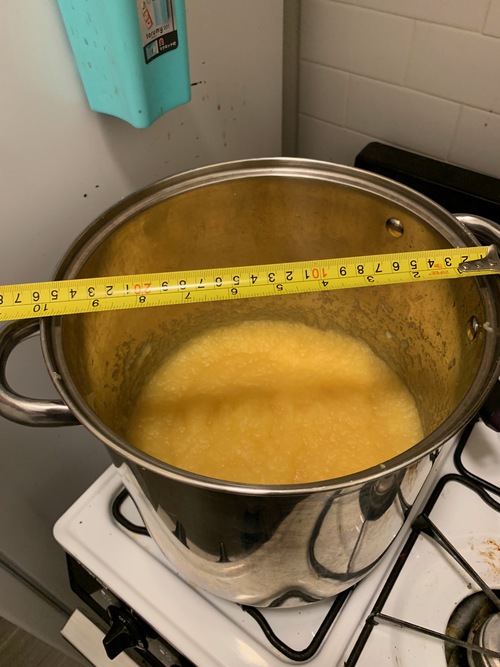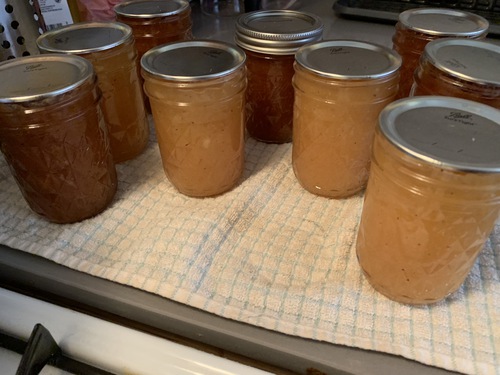I used the formula for the volume of a cylinder in real life for the first time ever and it went OK
For me, the phrase “pie dee over two squared aitch” (𝜋 (d½)² h) - also known as “pie are squared aitch” (𝜋r²h) - evokes images of university lectures; magnetic cylindrical rods, electric charge in a piece of wire. If you need to understand those things, you need to know how much space they take up in the world. Until the situation described here, I don’t think I’ve ever actually needed to calculate the volume of a cylinder outside of an exam.
Recently I found myself making a pretty large quantity of apple butter. I can’t say I’m apple butter’s greatest fan, but I’ve started cooking in bulk according to precise recipes and storing it all in glass jars at room temperature a.k.a. “canning”, and apple butter is a good introductory recipe.
The recipe looked simple enough, it’s basically apple sauce cooked for longer. The recipe asks you to boil 6 lbs of apples in 2 cups of apple cider for half an hour, blend it, then add 3 cups of sugar, some cinnamon and keep cooking for a few hours.
However, I hit a snag at the “blend it” stage. The recipe book suggested I transfer boiled apples to a blender for puréeing, then transfer them back to the pot. Such unnecessary effort! I’m pretty sure that immersion blenders had been invented by 2006 when this book was written.
I patted myself on the back as I transformed the contents of my pot of apples to mush and saved a significant quantity of cooking and washing labor. This was a figurative patting on the back. I recommend a two-handed grip for stick-blending large quantities of scalding hot apples.
Then I read on. The next step was “Measure 12 cups (3 L) of apple purée”, then the step after was to add the sugar, but if I had too much apple purée the ratio of sugar to purée might be off and so there might not be enough sugar to preserve the final product! I needed to be sure in that moment that I had the correct volume of apples. I resigned myself to having to wash a measuring jug after all
Then inspiration came to me. I ran to grab a tape measure. First I measured the height of the pot, starting from the top of the base.
then I measured the distance between the top of the purée and the top of the pot,
and finally I measured the diameter of the pot.
The two vertical measurements gave me 23 - 17 = 6cm for the depth of the purée, so I plugged in all the numbers. (25cm/2)² ⨉ 𝜋 ⨉ (23 - 17) cm = 2945cm³! Apparently I had managed to produce an almost perfectly correct volume of purée. Happy with this outcome, I followed the recipe to the end.
However, in retrospect I think I was being a bit cavalier with my measurements, rounding to the nearest 0.5 cm. If I were 0.25cm off the real measurements, how wrong could I be?
If my measurements overestimated the external height and diameter and underestimated the internal height all by 0.25cm, the real volume would have been (24.75 cm / 2)² ⨉ 𝜋 ⨉ (22.75 - 17.25) cm = 2646cm³, and I would have been 12% off the recipe. In the other direction, if the real volume were (26cm/2)² ⨉ 𝜋 ⨉ (23.25 - 16.75) cm = 3505cm³ I would have been 16% over!
That doesn’t seem so bad, but there was another mistake I could have made: if the tape measure was not perfectly vertical then I may actually have measured the longest side of a triangle formed by the side of the pan, the 1.5cm metal tip of the tape measure, and the tape itself, which would have resulted in an overestimate.
Thankfully, the Zhoubi Suanjing taught us that a² + b² = c². In the worst case, if my 23cm outside pan measurement had been angled and overestimated by 0.25cm, the real height would actually be a = sqrt(22.75² - 1.5²) = 22.70 cm, and the loss of 0.05cm would bring the real volume from 2646 cm³ to 2622 cm³. Think about that 40cm³ difference as 20 little-finger-tip sized cubes, or roughly 1/6 of a 8z jar of apple butter.
In any case, later on I messed up by undercooking the apple butter by about 3 hours, noticing my mistake after canning about half of the mixture into four 8oz jars, then cooking the rest for longer and canning it in five more 8oz jars, bringing me to 9 jars instead of the recipe-suggested 8, so in the end it was hard to know how accurate I really was.
But hey, at least I had fun measuring things. If you actually managed to get this far: thanks for your time!



